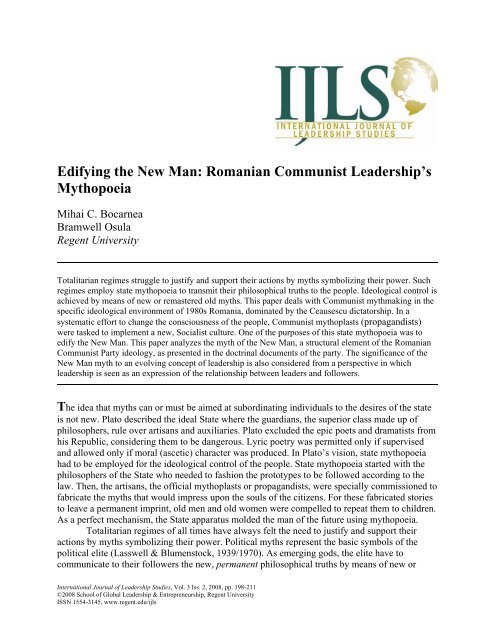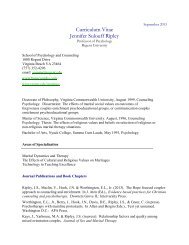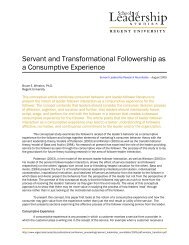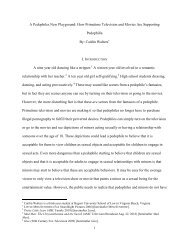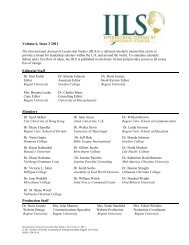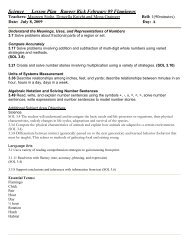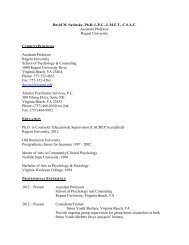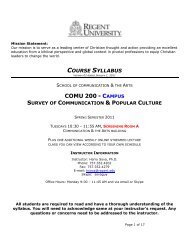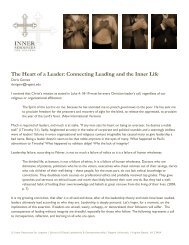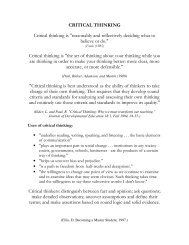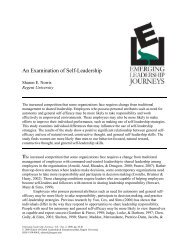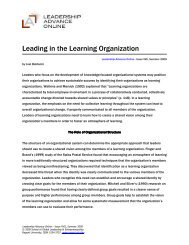Edifying the New Man: Romanian Communist ... - Regent University
Edifying the New Man: Romanian Communist ... - Regent University
Edifying the New Man: Romanian Communist ... - Regent University
You also want an ePaper? Increase the reach of your titles
YUMPU automatically turns print PDFs into web optimized ePapers that Google loves.
<strong>Edifying</strong> <strong>the</strong> <strong>New</strong> <strong>Man</strong>: <strong>Romanian</strong> <strong>Communist</strong> Leadership’s<br />
Mythopoeia<br />
Mihai C. Bocarnea<br />
Bramwell Osula<br />
<strong>Regent</strong> <strong>University</strong><br />
Totalitarian regimes struggle to justify and support <strong>the</strong>ir actions by myths symbolizing <strong>the</strong>ir power. Such<br />
regimes employ state mythopoeia to transmit <strong>the</strong>ir philosophical truths to <strong>the</strong> people. Ideological control is<br />
achieved by means of new or remastered old myths. This paper deals with <strong>Communist</strong> mythmaking in <strong>the</strong><br />
specific ideological environment of 1980s Romania, dominated by <strong>the</strong> Ceausescu dictatorship. In a<br />
systematic effort to change <strong>the</strong> consciousness of <strong>the</strong> people, <strong>Communist</strong> mythoplasts (propagandists)<br />
were tasked to implement a new, Socialist culture. One of <strong>the</strong> purposes of this state mythopoeia was to<br />
edify <strong>the</strong> <strong>New</strong> <strong>Man</strong>. This paper analyzes <strong>the</strong> myth of <strong>the</strong> <strong>New</strong> <strong>Man</strong>, a structural element of <strong>the</strong> <strong>Romanian</strong><br />
<strong>Communist</strong> Party ideology, as presented in <strong>the</strong> doctrinal documents of <strong>the</strong> party. The significance of <strong>the</strong><br />
<strong>New</strong> <strong>Man</strong> myth to an evolving concept of leadership is also considered from a perspective in which<br />
leadership is seen as an expression of <strong>the</strong> relationship between leaders and followers.<br />
The idea that myths can or must be aimed at subordinating individuals to <strong>the</strong> desires of <strong>the</strong> state<br />
is not new. Plato described <strong>the</strong> ideal State where <strong>the</strong> guardians, <strong>the</strong> superior class made up of<br />
philosophers, rule over artisans and auxiliaries. Plato excluded <strong>the</strong> epic poets and dramatists from<br />
his Republic, considering <strong>the</strong>m to be dangerous. Lyric poetry was permitted only if supervised<br />
and allowed only if moral (ascetic) character was produced. In Plato’s vision, state mythopoeia<br />
had to be employed for <strong>the</strong> ideological control of <strong>the</strong> people. State mythopoeia started with <strong>the</strong><br />
philosophers of <strong>the</strong> State who needed to fashion <strong>the</strong> prototypes to be followed according to <strong>the</strong><br />
law. Then, <strong>the</strong> artisans, <strong>the</strong> official mythoplasts or propagandists, were specially commissioned to<br />
fabricate <strong>the</strong> myths that would impress upon <strong>the</strong> souls of <strong>the</strong> citizens. For <strong>the</strong>se fabricated stories<br />
to leave a permanent imprint, old men and old women were compelled to repeat <strong>the</strong>m to children.<br />
As a perfect mechanism, <strong>the</strong> State apparatus molded <strong>the</strong> man of <strong>the</strong> future using mythopoeia.<br />
Totalitarian regimes of all times have always felt <strong>the</strong> need to justify and support <strong>the</strong>ir<br />
actions by myths symbolizing <strong>the</strong>ir power. Political myths represent <strong>the</strong> basic symbols of <strong>the</strong><br />
political elite (Lasswell & Blumenstock, 1939/1970). As emerging gods, <strong>the</strong> elite have to<br />
communicate to <strong>the</strong>ir followers <strong>the</strong> new, permanent philosophical truths by means of new or<br />
International Journal of Leadership Studies, Vol. 3 Iss. 2, 2008, pp. 198-211<br />
©2008 School of Global Leadership & Entrepreneurship, <strong>Regent</strong> <strong>University</strong><br />
ISSN 1554-3145, www.regent.edu/ijls
INTERNATIONAL JOURNAL OF LEADERSHIP STUDIES 199<br />
remastered old myths. The communication process is unbalanced. As Levi-Strauss (1973/1976)<br />
suggested, “men and <strong>the</strong> divine interlocutors are not partners in <strong>the</strong> same communication system”<br />
(p. 66). By manipulating symbols, myths, and tradition, <strong>the</strong> totalitarian state constructs a political<br />
culture in support of its political authority (Aronoff, 1986). Perhaps <strong>the</strong> most well known<br />
mythoplast of <strong>the</strong> 20th century, <strong>the</strong> Third Reich’s Minister of Propaganda Joseph Goebbels,<br />
raised myth making to a level previously unknown in Germany and, in <strong>the</strong> period 1933 - 1945,<br />
manipulated German culture toward a Nazi agenda. As known, a cornerstone of this agenda was<br />
<strong>the</strong> creation of <strong>the</strong> Aryan myth, a <strong>New</strong> <strong>Man</strong> concept that had wider ramifications for prosecution<br />
of <strong>the</strong> war and Nazi ideology.<br />
Although different in both form and content from <strong>the</strong> ideology of <strong>the</strong> German Nazis, <strong>the</strong><br />
doctrinal documents of <strong>the</strong> <strong>Romanian</strong> <strong>Communist</strong> Party (RCP) created <strong>the</strong> myth of a <strong>New</strong> <strong>Man</strong>, a<br />
<strong>Communist</strong> superhero belonging to <strong>the</strong> mythological side of <strong>Communist</strong> ideology. In our study,<br />
we traced <strong>the</strong> <strong>New</strong> <strong>Man</strong> mythopoeia as unfolded in <strong>the</strong> documents of <strong>the</strong> last two RCP<br />
congresses, <strong>the</strong> Thirteenth RCP Congress (1984) and <strong>the</strong> Fourteenth RCP Congress (1989), and<br />
<strong>the</strong> reports presented by <strong>the</strong> RCP Secretary General, Nicolae Ceausescu, at <strong>the</strong> two congresses.<br />
These reports were <strong>the</strong> ultimate, quintessential medium through which Ceausescu propagated, in<br />
ritualistic utterances, <strong>the</strong> party doctrine. The principles and system of belief presented in <strong>the</strong>se<br />
RCP documents were considered true and beyond dispute by <strong>the</strong> party and needed to be entirely<br />
accepted by <strong>the</strong> rest of <strong>the</strong> people as norms. Fur<strong>the</strong>rmore, <strong>the</strong>se documents of mythical<br />
proportions served to bolster Ceausescu’s own position in <strong>the</strong> party, state, and country as <strong>the</strong><br />
preeminent leader.<br />
The <strong>Communist</strong> mythmaking of 1980s Romania was specific to <strong>the</strong> ideological effort of<br />
<strong>the</strong> Ceausescu regime to change <strong>the</strong> people’s consciousness. In <strong>the</strong>ir quest to possess <strong>the</strong> soul of<br />
<strong>the</strong> individual, <strong>Communist</strong> mythoplasts promoted <strong>the</strong> new, Socialist culture. More specifically,<br />
<strong>the</strong>ir fundamental purpose was to edify <strong>the</strong> <strong>New</strong> <strong>Man</strong>, <strong>the</strong> guarantee of <strong>the</strong> Socialist future for <strong>the</strong><br />
country.<br />
In this paper, we use <strong>the</strong> term edify as <strong>the</strong> English word closest in meaning to <strong>the</strong><br />
<strong>Romanian</strong> a edifica, a term employed by <strong>the</strong> RCP to describe <strong>the</strong> process of making <strong>the</strong> superhero<br />
and a new society. Perhaps <strong>the</strong> RCP’s mythmakers considered <strong>the</strong> simpler version to build too<br />
prosaic for <strong>the</strong> needed esoteric flavor of <strong>the</strong>ir mythmaking. The Webster (1980) definitions for<br />
edify are to (a) instruct, (b) improve morally and spiritually, (c) build, (d) establish, and (e)<br />
enlighten. Indeed, all <strong>the</strong>se actions combined closely translate <strong>the</strong> ideological activities used by<br />
<strong>the</strong> party in propagating <strong>the</strong> new myth. To <strong>the</strong> extent that <strong>the</strong> term edification is value positive,<br />
<strong>the</strong> <strong>Romanian</strong> regime was able to bracket its <strong>New</strong> <strong>Man</strong> objective with a worthwhile, allegedly<br />
moral, flavor.<br />
Myths<br />
Theoretical Background<br />
Etymologically, mythopoeia comes from <strong>the</strong> Greek mythos, meaning myth, and poiein,<br />
meaning to make. Mythopoeia is mythmaking, myth as transformed by mythoplasts. Levi-Strauss<br />
(1962/1969) considered mythopoeia an intellectual form of bricolage. <strong>Man</strong>, in his attempt to<br />
make sense of reality, takes ei<strong>the</strong>r a scientific approach (<strong>the</strong> engineer) or a mythical one (<strong>the</strong><br />
bricoleur). On one hand, <strong>the</strong> engineer has all <strong>the</strong> tools he or she needs to follow his or her social<br />
plan of domination and change. On <strong>the</strong> o<strong>the</strong>r hand, <strong>the</strong> bricoleur puts toge<strong>the</strong>r <strong>the</strong> remains, debris<br />
International Journal of Leadership Studies, Vol. 3 Iss. 2, 2008, pp. 198-211<br />
©2008 School of Global Leadership & Entrepreneurship, <strong>Regent</strong> <strong>University</strong><br />
ISSN 1554-3145
Bocarnea & Osula/INTERNATIONAL JOURNAL OF LEADERSHIP STUDIES 200<br />
of history with whatever he or she has at hand to fulfill a more subtle plan. The bricoleurs make<br />
<strong>the</strong> myths and <strong>the</strong>n take <strong>the</strong>m for objective facts, trying to tack <strong>the</strong>m onto <strong>the</strong> rest of objective<br />
knowledge. The power of bricolage, to some extent, resides in its inherent creativity. The absence<br />
of a prescribed scientific path to mythmaking allows <strong>the</strong> individual mythoplast to make and<br />
unmake history and culture almost at will, deploying whatever tools are at hand. While <strong>the</strong><br />
linguistic connection between <strong>the</strong> terms mythopoeia, myopia, and utopia would make for an<br />
interesting study in what Berger and Luckmann (1966) referred to as <strong>the</strong> social construction of<br />
reality, this is outside <strong>the</strong> scope of <strong>the</strong> present paper.<br />
The Platonic mythos is a story whose truth is less vouched for and whose purpose is<br />
symbolic. Plato opposed mythos to logos, a rational and accurate story that is true and reliable.<br />
Myths are traditional stories accompanying rituals purporting to tell of occasions when some<br />
institution or cult had <strong>the</strong>ir beginning and of <strong>the</strong> original act which set <strong>the</strong> precedent for this.<br />
Myths are “obscure in origin, protean in form, and ambiguous in meaning” (Ruthven, 1976, p. 1).<br />
They are <strong>the</strong> instruments by which man struggles to make experience intelligible to himself.<br />
According to Schorer (1960), myth is a “large, controlling image that gives philosophical<br />
meaning to <strong>the</strong> facts of ordinary life; that is, which has organizing value for experience” (p. 355).<br />
In order to be accepted as myths, <strong>the</strong> works of a political elite need to be adopted by <strong>the</strong><br />
rest of <strong>the</strong> people: “Individual works are all myths potentially, but it is <strong>the</strong>ir adoption through<br />
collective use, if it occurs, which actualizes <strong>the</strong>ir mythism” (Detienne, 1981/1986, p. 47). In<br />
totalitarian regimes, <strong>the</strong> totalitarian state forces <strong>the</strong> collective adoption of its ideological opus by<br />
putting pressure on <strong>the</strong> individual, striving for <strong>the</strong> total invasion of <strong>the</strong> individual. While <strong>the</strong> state<br />
manifests itself more obviously through actions in <strong>the</strong> material realm, <strong>the</strong> spiritual invasion exists<br />
in subtler forms. Analyzing <strong>the</strong> Soviet ideology, Shlapentokh (1986) unfolded its two-level<br />
structure:<br />
The first, pragmatic level reflects <strong>the</strong> “real” material life of <strong>the</strong> people and <strong>the</strong> policy of<br />
<strong>the</strong> Soviet political leadership, while <strong>the</strong> second, mythological level consists of various<br />
myths having little in common with <strong>the</strong> “objective reality.” . . . Official mythology is <strong>the</strong><br />
main way of legitimizing <strong>the</strong> Soviet system and demands only compliance with <strong>the</strong> status<br />
quo. In its mythological activity, Soviet ideology exerts special efforts to impose <strong>the</strong><br />
secondary reality on <strong>the</strong> Soviet people. The Soviet people are suggested to live already in<br />
a world in which Soviet mythological values are implemented in life, and <strong>the</strong>y, as well as<br />
<strong>the</strong>ir leaders, behave as <strong>the</strong>se values demand. (p. 12)<br />
Shlapentokh considered such official values as <strong>the</strong> leading role of <strong>the</strong> working class,<br />
internationalism, social equality, and Socialist democracy to be part of <strong>the</strong> mythological side of<br />
<strong>the</strong> official ideology. Planning, Socialist property, patriotism, science, education, and family<br />
make up <strong>the</strong> pragmatic level of ideology.<br />
Doctrines do not become operative unless <strong>the</strong>y are capable of generating some sort of<br />
imaginative symbolism. Kertzer (1988), for instance, argued that power must be expressed<br />
through symbolic guises and, <strong>the</strong>refore, “symbolism is necessary to prop up <strong>the</strong> governing<br />
political order” (p. 174). The mythical <strong>New</strong> <strong>Man</strong> proposed by <strong>the</strong> RCP was part of its struggle of<br />
imposing <strong>the</strong> new Socialist cultural paradigm. According to Frye (1976), a myth is a “cultural<br />
model, expressing <strong>the</strong> way in which man wants to shape and reshape <strong>the</strong> civilization he himself<br />
has made” (p. 21). The <strong>New</strong> <strong>Man</strong> was <strong>the</strong> needed symbol of <strong>the</strong> emerging <strong>Romanian</strong> Socialist<br />
culture. <strong>Edifying</strong> him became an important goal of <strong>the</strong> <strong>Communist</strong> ideology. Although employed<br />
in classic analyses of capitalist relations, Lukács’ (1971) concept of reification is appropriate in<br />
this instance: “A relation between people takes on <strong>the</strong> character of a thing and thus acquires a<br />
International Journal of Leadership Studies, Vol. 3 Iss. 2, 2008, pp. 198-211<br />
©2008 School of Global Leadership & Entrepreneurship, <strong>Regent</strong> <strong>University</strong><br />
ISSN 1554-3145
INTERNATIONAL JOURNAL OF LEADERSHIP STUDIES 201<br />
‘phantom objectivity,’ an autonomy that seems so strictly rational and all-embracing as to conceal<br />
every trace of its fundamental nature” (p. 83). Subsequently, a successful myth is a myth that, in<br />
<strong>the</strong> minds of people, comes to be equated with truth or reality.<br />
Myths and Ideology<br />
If a political myth is accepted within a state by a large fraction of its people, that myth<br />
becomes ideology. Ideology, <strong>the</strong>refore, is actively and explicitly concerned with <strong>the</strong><br />
establishment and defense of values and beliefs. Subsequently, ideology converges on ideological<br />
consciousness in its two interpretations: (a) “a supernatural, religious ersatz world that affords<br />
man an illusory compensation for his real misery” (Barth, 1974/1976, p. 100) and (b) “a<br />
philosophy whose sole purpose is to offer an apology for existing social conditions” (Barth, p.<br />
100). In <strong>the</strong> specific context of this study, ideology was a major driving social force in<br />
<strong>Communist</strong> Romania. Fur<strong>the</strong>rmore, <strong>Communist</strong> ideology was employed to provide <strong>the</strong> necessary<br />
meaning and reinforcement to Ceausescu’s leadership. Central to this ideology was <strong>the</strong> myth of<br />
<strong>the</strong> <strong>New</strong> <strong>Man</strong>.<br />
Myths, whe<strong>the</strong>r conceived as beliefs, historical narratives, or fantasy legends, are<br />
compelling forms of ideology. Ideology is quite literally what its name suggests: <strong>the</strong> logic of an<br />
idea. Its subject matter is history to which <strong>the</strong> idea is applied. As Arendt (1958) put it, <strong>the</strong> result<br />
of this application is “not a body of statements about something that is, but <strong>the</strong> unfolding of a<br />
process which is in constant change” (p. 468). The myth of <strong>the</strong> <strong>New</strong> <strong>Man</strong>, <strong>the</strong> godly man created<br />
by <strong>the</strong> RCP in its own image, was built around <strong>the</strong> becoming of an all-powerful man. The myth<br />
was meant to fur<strong>the</strong>r establish <strong>the</strong> domination of <strong>the</strong> <strong>Communist</strong> state over its citizens. After all,<br />
ideology represents <strong>the</strong> implicit power behind propaganda because of its alleged ability to<br />
convince <strong>the</strong> public to believe in that which is unreal.<br />
An ideology treats <strong>the</strong> course of events as though it followed <strong>the</strong> same law as <strong>the</strong> logical<br />
exposition of its idea. Again, Arendt (1958) considered that “ideologies pretend to know <strong>the</strong><br />
mysteries of <strong>the</strong> whole historical process—<strong>the</strong> secrets of <strong>the</strong> past, <strong>the</strong> intricacies of <strong>the</strong> present,<br />
<strong>the</strong> uncertainties of <strong>the</strong> future—because of <strong>the</strong> logic inherent in <strong>the</strong>ir respective ideas” (p. 469).<br />
This was precisely <strong>the</strong> working ideological strategy of <strong>the</strong> RCP.<br />
Boudon (1986/1989) proposed two sets of definitions of ideology, those based on <strong>the</strong><br />
criterion of true and false and those not based on this criterion. This distinction is unambiguous<br />
even within <strong>the</strong> Marxist tradition. In Boudon’s interpretation, on one hand, Marx considered<br />
ideology a science of ideas in which ideas are truthful representations of reality. Never<strong>the</strong>less, for<br />
Marx, ideology is a false science in <strong>the</strong> fact that it reflects ideas which, in actuality, result from<br />
<strong>the</strong> material interaction of social factors. In Marxist interpretation, <strong>the</strong> process resembles a<br />
camera obscura transformation of real objects into upside-down images. On <strong>the</strong> o<strong>the</strong>r hand,<br />
Boudon argues that Lenin was less interested in whe<strong>the</strong>r <strong>the</strong> ideology was a truthful<br />
representation of reality or not and more interested in its effectiveness. Lenin strongly believed<br />
that ideology is a useful tool to be used as a weapon in <strong>the</strong> class struggle. The Leninist<br />
interpretation has been fundamental to <strong>Communist</strong> propaganda of all times as ideology has<br />
always been considered a tool of forcing and enforcing <strong>the</strong> desired social changes.<br />
Unsurprisingly, it was this Leninist view of ideology as a social weapon that <strong>the</strong> RCP used in<br />
building its myth of <strong>the</strong> <strong>New</strong> <strong>Man</strong>. The fabrication of <strong>Communist</strong> myths was <strong>the</strong> natural outcome<br />
of <strong>the</strong> RCP’s propaganda. If propaganda was <strong>the</strong> action through which <strong>the</strong> RCP openly forced its<br />
dogma on <strong>the</strong> people, <strong>the</strong>n mythopoeia was <strong>the</strong> act of fabricating myths and insinuating <strong>the</strong>m into<br />
International Journal of Leadership Studies, Vol. 3 Iss. 2, 2008, pp. 198-211<br />
©2008 School of Global Leadership & Entrepreneurship, <strong>Regent</strong> <strong>University</strong><br />
ISSN 1554-3145
Bocarnea & Osula/INTERNATIONAL JOURNAL OF LEADERSHIP STUDIES 202<br />
<strong>the</strong> culture. Following <strong>the</strong> Leninist practice, <strong>the</strong> <strong>Romanian</strong> <strong>Communist</strong> mythopoeia was<br />
deliberately focused on social change.<br />
The Myth of <strong>the</strong> <strong>New</strong> <strong>Man</strong><br />
In <strong>the</strong> 1950s, a significant moment in critical studies was <strong>the</strong> shift from rhetoric to myth<br />
analysis. This shift engendered a new species of criticism: myth criticism. Frye (1957) stated that<br />
all stories can be examined not only in terms of <strong>the</strong>ir individual, stylistic, literary qualities but<br />
also in terms of <strong>the</strong> overarching myths that <strong>the</strong>y reincarnate. In our study, analyzing <strong>the</strong><br />
mythopoeia of <strong>the</strong> <strong>New</strong> <strong>Man</strong> in <strong>the</strong> selected doctrinal texts of <strong>the</strong> RCP was a difficult task. The<br />
complex myth found in <strong>the</strong> documents we analyzed was veiled by <strong>the</strong> conceptual, discursive,<br />
propagandistic language of <strong>the</strong> ideologues. Probing beneath <strong>the</strong> outer layers of <strong>the</strong> doctrinal texts<br />
with <strong>the</strong>ir stock Socialist ideology became <strong>the</strong> means whereby we uncovered <strong>the</strong> ideational<br />
concept of <strong>the</strong> <strong>New</strong> <strong>Man</strong>.<br />
Aronoff (1986) considered that one of <strong>the</strong> reasons for <strong>the</strong> strength of a myth is that it<br />
“presents a more lucid and compelling image than do abstract principles. In addition, an account<br />
of <strong>the</strong> past which justifies a present course of action is attractive to most people” (p. 17). In its<br />
simplest form, <strong>the</strong> myth-as-story underscores <strong>the</strong> power of <strong>the</strong> narrative in communicating<br />
meaning and may reveal <strong>the</strong> force of myth creation in all cultural contexts from preschool stories<br />
to media campaigns. As a political myth, <strong>the</strong> myth of a <strong>New</strong> <strong>Man</strong> is built to mobilize collective<br />
action by posing collective responsibilities. The <strong>Romanian</strong> <strong>Communist</strong> mythoplasts selected and<br />
manipulated symbols of <strong>the</strong> traditional culture to recreate a political identity that was both linked<br />
to <strong>the</strong> past and made compatible with <strong>the</strong> political goals of <strong>the</strong> <strong>Communist</strong> future. The formula<br />
was to construct <strong>the</strong> future in <strong>the</strong> present and to deploy <strong>the</strong> myth as an agent of cultural change.<br />
As with all <strong>Communist</strong> myths, <strong>the</strong> <strong>New</strong> <strong>Man</strong> mythopoeia had a strategic appreciation of<br />
time. As <strong>Man</strong>nheim (1936) suggested, in myths “time is always experienced as a series of<br />
strategical points” (p. 244). This <strong>Communist</strong> superman was <strong>the</strong> desired cultural bridge between<br />
Romania’s past and its <strong>Communist</strong> future. It is commonly accepted that every faith and every<br />
state has its own myth (Gorner, 1992). Naturally, <strong>Romanian</strong> overtones of <strong>the</strong> Socialist culture<br />
promoted by <strong>the</strong> state ideologues and mythoplasts became part of <strong>the</strong> myth-making effort. They<br />
became evident at <strong>the</strong> 1976 ideological conference of <strong>the</strong> RCP. For instance, one of its outcomes<br />
was <strong>the</strong> ideological campaign developed around <strong>the</strong> slogan Cantarea Romaniei (Hymn to<br />
Romania). The artistic festival associated with <strong>the</strong> Hymn became <strong>the</strong> potent ritualistic arm of <strong>the</strong><br />
<strong>Communist</strong> mythopoeic effort. The ritual and ceremony of <strong>the</strong> Hymn endowed <strong>the</strong> RCP’s<br />
political actions with a degree of legitimacy warranted by <strong>Romanian</strong> history. As Gilbert (1976)<br />
observed, <strong>the</strong> party was using a “concerted campaign to enhance its image as a national force<br />
which is carrying on <strong>the</strong> traditions of <strong>the</strong> great liberators of <strong>Romanian</strong> history” (p. 304).<br />
According to Highet (1996), myths can be interpreted on <strong>the</strong> basis of three main<br />
principles: “One is to say that <strong>the</strong>y describe single historical facts. The second is to take <strong>the</strong>m as<br />
symbols of permanent philosophical truths. The third is to hold that <strong>the</strong>y are reflections of natural<br />
processes, eternally recurring” (p. 183). Although <strong>the</strong> best mythoplasts seek to create myths that<br />
reflect each of <strong>the</strong>se three principles, <strong>the</strong> reality is that myths are usually less grounded. In that<br />
regard, <strong>the</strong> <strong>New</strong> <strong>Man</strong> was a myth designed mainly to pass <strong>the</strong> <strong>Communist</strong> permanent<br />
philosophical truths on to <strong>the</strong> <strong>Romanian</strong> people.<br />
In <strong>the</strong> next section of <strong>the</strong> paper, <strong>the</strong> texts of <strong>the</strong> RCP doctrinal documents addressing <strong>the</strong><br />
<strong>New</strong> <strong>Man</strong> are deconstructed following <strong>the</strong> definitions and characteristics of myths proposed by<br />
International Journal of Leadership Studies, Vol. 3 Iss. 2, 2008, pp. 198-211<br />
©2008 School of Global Leadership & Entrepreneurship, <strong>Regent</strong> <strong>University</strong><br />
ISSN 1554-3145
INTERNATIONAL JOURNAL OF LEADERSHIP STUDIES 203<br />
Murray (1960) to <strong>the</strong> chosen <strong>Communist</strong> myth. The purpose of <strong>the</strong> method was threefold: (a) to<br />
prove that <strong>the</strong> <strong>New</strong> <strong>Man</strong> concept has mythical characteristics, (b) to actually analyze <strong>the</strong> myth,<br />
and (c) to identify <strong>the</strong> broader leadership framework within which myth making occurs as each of<br />
<strong>the</strong> individual elements of <strong>the</strong> myth identified by Murray has a functional role in <strong>the</strong> leadership<br />
framework.<br />
Descriptive Definition<br />
Murray (1960) stated that a myth manifestly consists of <strong>the</strong> “essential features of an<br />
important . . . situation that has a basic <strong>the</strong>ma in which at least one extraordinary . . . psychic<br />
entity is involved” (p. 319). That important situation of <strong>the</strong> <strong>New</strong> <strong>Man</strong> was described by <strong>the</strong> party<br />
as <strong>the</strong> beginning of a new stage in <strong>the</strong> development of <strong>the</strong> <strong>Romanian</strong> <strong>Communist</strong> society: “Now<br />
that we are entering a superior era of development of our Socialist society, we need to be<br />
conscious that it is an objective imperative to build <strong>the</strong> <strong>New</strong> <strong>Man</strong>” (Ceausescu, 1989, p. 3).<br />
Ceausescu (1989) fur<strong>the</strong>r stressed <strong>the</strong> building of this myth: “The great economical–social and<br />
political changes that have occurred both in our country and internationally, <strong>the</strong> great<br />
achievements of science and technology, of human knowledge generally, all <strong>the</strong>se demand <strong>the</strong><br />
edifying of <strong>the</strong> new man” (p. 4).<br />
The extraordinary psychic entity was <strong>the</strong> <strong>Communist</strong> Superman, a man of great<br />
importance for <strong>the</strong> national being. He was not <strong>the</strong> average, all-too-human mortal, but a man<br />
becoming god, critical for <strong>the</strong> welfare of society. Ceausescu (1989) defined this superhero as a<br />
builder of <strong>the</strong> socialism and communism, with a large horizon of <strong>the</strong>oretical, scientific, and<br />
professional knowledge, with a militant revolutionary spirit. The <strong>New</strong> <strong>Man</strong> was a perennial<br />
revolutionary, forever leading <strong>the</strong> transformation of society, with <strong>the</strong> <strong>Communist</strong> goal in mind.<br />
O<strong>the</strong>r defining characteristics of <strong>the</strong> <strong>New</strong> <strong>Man</strong>, as presented by Ceausescu (1984), were his<br />
Socialist revolutionary patriotism and his love of country and fellow citizens. The <strong>New</strong> <strong>Man</strong> was<br />
devoted to <strong>the</strong> achievements of socialism, working ceaselessly at building <strong>the</strong> Socialist and<br />
<strong>Communist</strong> future in his fa<strong>the</strong>rland. He also defended <strong>the</strong> revolutionary achievements, <strong>the</strong><br />
independence, and <strong>the</strong> sovereignty of his fa<strong>the</strong>rland.<br />
Referential Definition<br />
A myth needs a phenomenal reference, allowing <strong>the</strong> manifest components of <strong>the</strong> myth to<br />
“mean what <strong>the</strong>y literally appear to mean or may stand for anything else that is conceivable by<br />
man” (Murray, 1960, p. 330). The myth of <strong>the</strong> <strong>New</strong> <strong>Man</strong> was a collective myth, reflecting<br />
desirable actions and aspirations of <strong>the</strong> whole society. The language in which <strong>the</strong> expected<br />
actions of <strong>the</strong> mythical <strong>Man</strong> were depicted was general, norm-laden: “<strong>the</strong> <strong>New</strong> man needs to keep<br />
alive <strong>the</strong> renewing, revolutionary spirit of <strong>the</strong> party and to increase its leading role” (Ceausescu,<br />
1984, p. 4). However, <strong>the</strong> lack of precision in describing <strong>the</strong> <strong>New</strong> <strong>Man</strong>’s mythical actions was<br />
strategic, allowing room for future adjustments in <strong>the</strong> party’s ideology, ra<strong>the</strong>r than reactive.<br />
A myth has a clear temporal reference, described by Murray (1960) as “essential features<br />
of imagined situations or events that occurred in <strong>the</strong> past, are destined to occur in <strong>the</strong> future, or<br />
are now recurring” (p. 333). In this regard, <strong>the</strong> <strong>New</strong> <strong>Man</strong> was a prospective myth, pointing<br />
toward an ultimate better world—<strong>the</strong> <strong>Communist</strong> society. To some extent, this better world was<br />
conceived in utopian terms as <strong>the</strong> world was remade in <strong>the</strong> image of <strong>the</strong> <strong>New</strong> <strong>Man</strong>. As an<br />
expression of this idealized construct, Ceausescu (1984) charged <strong>the</strong> <strong>New</strong> <strong>Man</strong> with “a historical<br />
International Journal of Leadership Studies, Vol. 3 Iss. 2, 2008, pp. 198-211<br />
©2008 School of Global Leadership & Entrepreneurship, <strong>Regent</strong> <strong>University</strong><br />
ISSN 1554-3145
Bocarnea & Osula/INTERNATIONAL JOURNAL OF LEADERSHIP STUDIES 204<br />
mission to lead <strong>the</strong> <strong>Romanian</strong> society to higher peaks of Socialist civilization, toward <strong>the</strong><br />
fulfillment of <strong>the</strong> golden dream of mankind—<strong>the</strong> <strong>Communist</strong> society” (p. 4). The heroism of <strong>the</strong><br />
<strong>New</strong> <strong>Man</strong> was fully supported and inspired by <strong>the</strong> past of <strong>the</strong> country. The <strong>New</strong> <strong>Man</strong> was <strong>the</strong><br />
fulfillment of <strong>the</strong> ancestors’ dreams, ancestors who fought “heroic battles, animated by <strong>the</strong>ir trust<br />
in <strong>the</strong> <strong>Romanian</strong> people, in his independent future” (Ceausescu, 1984, p. 5).<br />
Functional Definition<br />
After estimating <strong>the</strong> powers of a myth in terms of its social scope and temporal span, <strong>the</strong><br />
influential representation accomplished by a myth needs to be estimated in terms of <strong>the</strong> average<br />
intensity of its desired effects, “<strong>the</strong>se effects being of five classes: (a) cynosural–emotional–<br />
memorable–inspirational, (b) convictional, (c) evaluational, (d) conational, and (e) integrational”<br />
(Murray, 1960, p. 335).<br />
The myth of <strong>the</strong> <strong>New</strong> <strong>Man</strong> was designed to be <strong>the</strong> focus of <strong>the</strong> rapt attention, thought, and<br />
talk. To elicit this cynosural function of <strong>the</strong> myth, <strong>the</strong> party put <strong>the</strong> <strong>New</strong> <strong>Man</strong> at <strong>the</strong> center of its<br />
ideological production. The emotional effect was expected to be significant especially when<br />
mythoplasts addressed those who were easier to mold, <strong>the</strong> younger generation, as <strong>the</strong> generation<br />
that supposedly had not been “spoiled” or contaminated by older myths: “Dear young friends, all<br />
your actions should be in <strong>the</strong> spirit of <strong>the</strong> revolutionary romanticism” (Ceausescu, 1984, p. 5).<br />
The <strong>New</strong> <strong>Man</strong> myth engendered hope, aiming for emphatic identification of <strong>the</strong> people with <strong>the</strong><br />
proposed myth. Moreover, <strong>the</strong> Party needed a memorable myth, with recurrent imprint in <strong>the</strong><br />
minds of its receptors. Thus, <strong>the</strong> myth was presented frequently and consistently every time a<br />
major political RCP activity took place. The myth, as presented at <strong>the</strong>se major events, suffered<br />
little or no changes in time. As expected, <strong>the</strong> two analyzed texts, although separated by 4 years,<br />
showed little variation in <strong>the</strong> description of <strong>the</strong> <strong>New</strong> <strong>Man</strong>. Repetition was supposed to produce<br />
retention.<br />
The last item of <strong>the</strong> first class of myth functions is, according to Murray (1960), <strong>the</strong><br />
inspirational function. Myth needs to inspire receptors with artistic gifts to reproduce and<br />
propagate <strong>the</strong> myth. The <strong>Romanian</strong> <strong>Communist</strong> mythoplasts considered this function to be crucial<br />
for <strong>the</strong> viability of <strong>the</strong>ir mythical product:<br />
We must create new literary opuses, with a higher patriotic content, new movie pictures,<br />
and plays mirroring <strong>the</strong> life and achievements of our people, in <strong>the</strong> spirit of <strong>the</strong><br />
revolutionary, Socialist humanism. . . . We need new revolutionary and patriotic songs,<br />
inspired from <strong>the</strong> life of our people and his melodious spirit. . . . All <strong>the</strong> arts are called to<br />
build <strong>the</strong> new man, inspired by <strong>the</strong> process of edifying him. (Ceausescu, 1989, p. 4)<br />
A myth needs to elicit belief or faith in its validity in order to be convictional. The <strong>New</strong><br />
<strong>Man</strong> myth needed, <strong>the</strong>refore, to be perceived as truth, not falsehood. Subsequently, <strong>Communist</strong><br />
ideologues aimed at transforming <strong>the</strong>ir myths into objective realities. It was important for <strong>the</strong>m to<br />
pay close attention to <strong>the</strong> myths’ validity. After all, <strong>the</strong> bottom-line value of a myth like <strong>the</strong> <strong>New</strong><br />
<strong>Man</strong> was its ability to convince people. A convictional myth gives legitimity to its makers.<br />
The myth of <strong>the</strong> <strong>New</strong> <strong>Man</strong> was also evaluational. It propagated, revived, and reestablished<br />
veneration for what it represented. The <strong>New</strong> <strong>Man</strong> was highly valued by <strong>the</strong> party and<br />
was sacred in <strong>the</strong> conscience of its carriers. The entire ideological and educative activity of <strong>the</strong><br />
RCP was centered on edifying <strong>the</strong> superhero.<br />
In Murray’s (1960) opinion, <strong>the</strong> conational function of a myth has two opposite<br />
manifestations: (a) eductional [sic], guiding and conducting valued actions, and (b) deterrent,<br />
International Journal of Leadership Studies, Vol. 3 Iss. 2, 2008, pp. 198-211<br />
©2008 School of Global Leadership & Entrepreneurship, <strong>Regent</strong> <strong>University</strong><br />
ISSN 1554-3145
INTERNATIONAL JOURNAL OF LEADERSHIP STUDIES 205<br />
suppressing disvalued actions. The <strong>New</strong> <strong>Man</strong> myth had both manifestations of <strong>the</strong> conational<br />
function. The hero, as presented by <strong>the</strong> RCP doctrinal documents, needed to struggle against any<br />
retrograde capitalist ideas that ei<strong>the</strong>r infiltrated from abroad or were remnants of <strong>the</strong> past<br />
<strong>Romanian</strong> bourgeoisie. The <strong>New</strong> <strong>Man</strong> had to take firm action against any manifestation of<br />
nationalism, chauvinism, mysticism, obscurantism, egotism, laziness, and dishonesty (Ceausescu,<br />
1984). On <strong>the</strong> o<strong>the</strong>r hand, <strong>the</strong> eductional [sic] function of <strong>the</strong> myth manifested in its alleged<br />
capacity of serving a model for all <strong>the</strong> individuals in <strong>the</strong> <strong>Romanian</strong> society. They were expected<br />
to identify <strong>the</strong>mselves with <strong>the</strong> proposed superman, always just, honest, a bearer of <strong>the</strong> new<br />
Socialist ethics. As a collective eductional [sic] myth, <strong>the</strong> <strong>New</strong> <strong>Man</strong> represented <strong>the</strong> ongoing<br />
conflict between good and bad forces. Conceived to some extent as a zero sum game, <strong>the</strong> gains of<br />
one side were interpreted as losses for <strong>the</strong> o<strong>the</strong>r. Viewed in such calculation of gains and losses<br />
terms, <strong>the</strong> importance of total victory and <strong>the</strong> silencing of critics may be better understood. As <strong>the</strong><br />
purveyor of a new cultural ethos, <strong>the</strong> <strong>Communist</strong> propagandists waged its <strong>New</strong> <strong>Man</strong> war using<br />
weapons (strategies) that were both offensive and defensive, both positive (in a task-oriented,<br />
value-free sense) and negative. According to Murray, <strong>the</strong> forces which are in line with <strong>the</strong><br />
group’s welfare are <strong>the</strong> good ones, engaged in a crucial conflict with <strong>the</strong> malefic forces:<br />
It is a struggle-to-<strong>the</strong>-finish between <strong>the</strong> forces of good and evil in one or ano<strong>the</strong>r guise—<br />
light and darkness, renewal and decay, evolution and stagnation, unity and disunity,<br />
conservation and destruction, life and death—forces which have been commonly<br />
embodied in two opposing supernatural beings (e.g. God and Devil) and more recently in<br />
two opposing -isms (e.g. Communism and Capitalism). (p. 338)<br />
The last functional characteristic of a myth, integration, is represented by <strong>the</strong> <strong>New</strong> <strong>Man</strong><br />
collective attribute. This myth unified <strong>the</strong> <strong>Romanian</strong> society, preventing it from disintegration.<br />
The hero was to be a “force which shines like <strong>the</strong> bright sun on <strong>the</strong> road to Communism, <strong>the</strong> era<br />
when all <strong>the</strong> people will be masters of <strong>the</strong>ir destinies” (Ceausescu, 1989, p. 6). The party also<br />
used <strong>the</strong> integrative mythical function to smooth <strong>the</strong> ethnic differences between <strong>the</strong> <strong>Romanian</strong><br />
majority and <strong>the</strong> ethnic minorities living on <strong>the</strong> <strong>Romanian</strong> territory. This integrative aspect of <strong>the</strong><br />
myth is particularly important in a differentiated society where a constellation of sociocultural<br />
differences constantly hammer at <strong>the</strong> national integrity of <strong>the</strong> state. Integration becomes <strong>the</strong><br />
nation-building component of <strong>the</strong> myth with identity and belonging as vital subcomponents. In<br />
this regard, <strong>the</strong> <strong>New</strong> <strong>Man</strong> spoke a language common to all, regardless of <strong>the</strong>ir ethnicity, <strong>the</strong><br />
language of labor, as Ceausescu (1989) himself labeled it.<br />
A myth must be represented in “words spoken by an appointed agent during <strong>the</strong> event’s<br />
ceremonial enaction at a prescribed place and time” (Murray, 1960, p. 339). The appointed agent<br />
of <strong>the</strong> <strong>Romanian</strong> <strong>New</strong> <strong>Man</strong> myth was <strong>the</strong> Secretary General of <strong>the</strong> party. His speeches were<br />
always highly ritualistic. There was hardly any major speech of Ceausescu that addressed <strong>the</strong><br />
ideology of <strong>the</strong> party without referring to <strong>the</strong> myth of <strong>the</strong> <strong>New</strong> <strong>Man</strong>. The rituals included<br />
carefully staged, “spontaneous” outpouring of popular support for <strong>the</strong> Party, <strong>the</strong> leader, and <strong>the</strong>ir<br />
ideology. While <strong>the</strong> <strong>New</strong> <strong>Man</strong> myth was analytically distinct from <strong>the</strong> personage of its chief<br />
mythoplast, <strong>the</strong> Secretary General, in practice, <strong>the</strong> two can became synonymous, at least<br />
implicitly. In <strong>the</strong> eyes of <strong>the</strong> people, <strong>the</strong> leader took on <strong>the</strong> characteristics of <strong>the</strong> <strong>New</strong> <strong>Man</strong> earlier<br />
than his followers. Ceausescu, <strong>the</strong> Supreme Leader, became <strong>the</strong> archetypal <strong>New</strong> <strong>Man</strong>. The<br />
mouthpiece became <strong>the</strong> phenomenal reference who, in turn, became <strong>the</strong> hero himself (<strong>the</strong> <strong>New</strong><br />
<strong>Man</strong>). Lenin, Mao, and, to a lesser extent, General Tito of <strong>the</strong> former Yugoslavia were exemplars<br />
of this process. However, less powerful but similar identifications of <strong>the</strong> messenger with <strong>the</strong><br />
International Journal of Leadership Studies, Vol. 3 Iss. 2, 2008, pp. 198-211<br />
©2008 School of Global Leadership & Entrepreneurship, <strong>Regent</strong> <strong>University</strong><br />
ISSN 1554-3145
Bocarnea & Osula/INTERNATIONAL JOURNAL OF LEADERSHIP STUDIES 206<br />
message or objective can be found in o<strong>the</strong>r leaders from FDR and Winston Churchill to Mahatma<br />
Gandhi and Nelson <strong>Man</strong>dela.<br />
Causal Definition<br />
A myth is also “a product of imaginations oriented and sustained by one or more basic<br />
needs and feelings in response to a critical situation which is experienced, consciously or<br />
unconsciously, by <strong>the</strong> society as whole, by members of a class, or by individuals as persons”<br />
(Murray, 1960, p. 342). The <strong>New</strong> <strong>Man</strong> myth was designed to prevent intolerable conflicts, curing<br />
contradictions that might appear in <strong>the</strong> Socialist system. The <strong>New</strong> <strong>Man</strong> was <strong>the</strong> conscious builder<br />
of <strong>the</strong> <strong>Communist</strong> future. He understood <strong>the</strong> society and its possible conflicts and solved <strong>the</strong>m<br />
according to his overall plan—Communism. The myth, in this sense, was a <strong>the</strong>rapy more for <strong>the</strong><br />
system than for <strong>the</strong> individual. The <strong>New</strong> <strong>Man</strong> was presented as a powerful change tool that would<br />
alter <strong>the</strong> character of <strong>Romanian</strong> society. Convincing <strong>the</strong> people to accept a degree of suffering—<br />
<strong>the</strong> importance of present sacrifices—was a necessary part of <strong>the</strong> myth making.<br />
The Mythopoeic <strong>New</strong> <strong>Man</strong><br />
The previous analysis finds <strong>the</strong> <strong>New</strong> <strong>Man</strong> as a collective prospective <strong>Communist</strong> myth<br />
with clear inspirational, eductional [sic], conational, and integrational functions. Each of <strong>the</strong>se<br />
functions plays into a broader leadership agenda in which <strong>the</strong> objectives of <strong>the</strong> individual<br />
(Ceausescu) become an expression of <strong>the</strong> organization (RCP). Both are <strong>the</strong>n reinterpreted as<br />
being similar in scope with a manifest national destiny.<br />
<strong>Edifying</strong> <strong>the</strong> <strong>New</strong> <strong>Man</strong> is mythopoeic in nature. Slochower (1976) stated that mythopoeia<br />
conveys a specific drama in three acts with an epilogue. The drama begins with a disrupted unity<br />
in <strong>the</strong> circumstances of <strong>the</strong> hero—a failure of conviction, a disturbance of faith, or a moral fall.<br />
The <strong>New</strong> <strong>Man</strong>’s surrogate drama began with <strong>the</strong> hero being uncomfortable with <strong>the</strong> Socialist<br />
present which, while better than <strong>the</strong> bourgeois past, was never<strong>the</strong>less far from <strong>the</strong> <strong>Communist</strong><br />
bright future. The <strong>New</strong> <strong>Man</strong> identified new contradictions in <strong>the</strong> Socialist society and articulated<br />
a leadership agenda that attempted to solve <strong>the</strong>se contradictions. This inspired a quest, a pursuit<br />
of <strong>the</strong> social circumstances previously taken for granted.<br />
The quest, <strong>the</strong> second act of <strong>the</strong> mythopoeic drama, involves <strong>the</strong> hero in a transgression<br />
against what his social group regards as a natural or sacred order. It is now <strong>the</strong> time when <strong>the</strong><br />
hero becomes <strong>the</strong> agent of transformation of his culture. Transforming himself continuously, <strong>the</strong><br />
<strong>New</strong> <strong>Man</strong> was always one step into <strong>the</strong> future. He was a perennial revolutionary: “The<br />
revolutionary process will continue even in <strong>the</strong> <strong>Communist</strong> society, it will never end”<br />
(Ceausescu, 1984, p. 5). The hero was a permanent agent of change of his society.<br />
The third act of Slochower’s (1976) mythopoeia is a kind of homecoming, a recreation, or<br />
a rebirth. The hero revitalizes his relationship to <strong>the</strong> tradition he has violated. The victory of <strong>the</strong><br />
mythopoeic hero is <strong>the</strong> victory of social morality. The hero alters <strong>the</strong> tradition in its parts that<br />
have become corrupt and stale. It is Communism that <strong>the</strong> <strong>New</strong> <strong>Man</strong> was supposed to bring into<br />
being, <strong>the</strong> new order built from <strong>the</strong> ashes of <strong>the</strong> old one. In <strong>the</strong> <strong>Communist</strong> mythopoeia, <strong>the</strong> <strong>New</strong><br />
<strong>Man</strong> seems to never find his homecoming as he restlessly is preoccupied with <strong>the</strong> best society to<br />
be achieved by mankind—Communism. This set <strong>the</strong> stage for an ongoing revolution or <strong>the</strong><br />
endless remaking of tomorrow’s world.<br />
International Journal of Leadership Studies, Vol. 3 Iss. 2, 2008, pp. 198-211<br />
©2008 School of Global Leadership & Entrepreneurship, <strong>Regent</strong> <strong>University</strong><br />
ISSN 1554-3145
INTERNATIONAL JOURNAL OF LEADERSHIP STUDIES 207<br />
Slochower (1976) considered that a tragic epilogue usually ends <strong>the</strong> three-act mythopoeia:<br />
<strong>the</strong> hero’s final sacrifice. Although it would be easy to interpret <strong>the</strong> 1989 revolution and<br />
subsequent overthrow of Ceaucescu and <strong>the</strong> RPI as <strong>the</strong> unexpected resolution of <strong>the</strong> <strong>New</strong> <strong>Man</strong><br />
myth, <strong>the</strong> truth is perhaps more blurry. Some might argue that <strong>the</strong> complex interleaving of<br />
individual, organizational, and national factors complicates matters and that <strong>Communist</strong><br />
mythoplasts clearly do not allow for tragic endings. Ra<strong>the</strong>r, <strong>the</strong> hero’s strivings seem to be<br />
resolved in a remote, paradisiac finale.<br />
Pseudo Epilogue<br />
In <strong>the</strong> final analysis, <strong>the</strong> <strong>Romanian</strong> <strong>Communist</strong> heroic <strong>New</strong> <strong>Man</strong> is nothing but a variant<br />
of Homo Sovieticus, a type of living being generated by <strong>the</strong> conditions of a society under a<br />
<strong>Communist</strong> regime. The dangers inherent in a lurking <strong>New</strong> <strong>Man</strong> myth are captured in Zinoviev’s<br />
(1982/1985) characterization of Homosos:<br />
The virus of Homosossery . . . is <strong>the</strong> gravest disease that can afflict mankind because it<br />
reaches to <strong>the</strong> very essence of <strong>the</strong> human being. If a man has sensed <strong>the</strong> Homosus in<br />
himself and tasted <strong>the</strong> poisons of Homosossery, it is more difficult to cure him of his<br />
disease than it is to return a burnt-out alcoholic or a junkie to a healthy life.<br />
Evolution-wise <strong>the</strong> Homosos is not decadent. On <strong>the</strong> contrary, he is <strong>the</strong> highest product of<br />
civilization. He is superman. He is universal. If need be, he can commit any frightfulness.<br />
Where it is possible, he can possess every virtue. There are no secrets which he cannot<br />
explain. There are no problems which he cannot solve. He is naive and simple. He is<br />
vacuous. He is omniscient and all-pervasive. He is replete with wisdom. He is a particle of<br />
<strong>the</strong> universe that bears <strong>the</strong> whole universe within itself. He is ready for anything and<br />
anyone. He is even ready for <strong>the</strong> best. He awaits it, although he doesn’t believe in it. He<br />
hopes for <strong>the</strong> worst. He is Nothing; that is to say, Everything. He is God, pretending to be<br />
<strong>the</strong> Devil. He is <strong>the</strong> Devil, pretending to be God. He is in every man. (p. 199)<br />
While few people actually believed any <strong>Communist</strong> myth during <strong>the</strong> Ceausescu regime,<br />
<strong>the</strong> damaging effects of <strong>the</strong> <strong>Communist</strong> ideology appeared to linger, surprisingly, after <strong>the</strong> fall of<br />
Communism. Even though Ceausescu had some sympathy from <strong>the</strong> West for holding out against<br />
Soviet pressure, <strong>the</strong> economic, social, and political changes in <strong>Romanian</strong> society, much like in<br />
o<strong>the</strong>r post-<strong>Communist</strong> societies, have been more or less hesitant. Whe<strong>the</strong>r <strong>the</strong> <strong>Communist</strong> <strong>New</strong><br />
<strong>Man</strong> myth was, in fact, more powerful than most are prepared to accept remains a lingering<br />
question. What cannot be denied is <strong>the</strong> inertia which has slowed down <strong>the</strong> transition of most ex-<br />
<strong>Communist</strong> countries from <strong>the</strong> old to <strong>the</strong> new social realities. While <strong>the</strong> poor economic conditions<br />
left behind by <strong>the</strong> <strong>Communist</strong> regimes were an objective reality influencing people’s beliefs, <strong>the</strong><br />
effect of <strong>Communist</strong> mythopoeia should also be taken into consideration. Apparently, <strong>the</strong> effect<br />
of <strong>Communist</strong> ideology survived <strong>the</strong> demise of <strong>the</strong> social system. This inertia has possible<br />
implications for leadership development and organizational change. Perhaps, as indirectly<br />
suggested by this study, ideological mythoplasts have a more significant impact on followers than<br />
social engineers.<br />
Karl Marx and Friedrich Engels (1848/2002) began The <strong>Communist</strong> <strong>Man</strong>ifesto with <strong>the</strong><br />
following statement: “A specter is haunting Europe—<strong>the</strong> specter of communism” (p. 27). These<br />
words are of greater actuality today than <strong>the</strong>y were at that time. The only difference is that <strong>the</strong><br />
specter is a ghost of a dying creature—<strong>the</strong> <strong>New</strong> <strong>Man</strong> that <strong>Communist</strong> regimes wanted to create. A<br />
hybrid result of adaptation to <strong>the</strong> harsh material condition of Socialism on one hand and a result<br />
International Journal of Leadership Studies, Vol. 3 Iss. 2, 2008, pp. 198-211<br />
©2008 School of Global Leadership & Entrepreneurship, <strong>Regent</strong> <strong>University</strong><br />
ISSN 1554-3145
Bocarnea & Osula/INTERNATIONAL JOURNAL OF LEADERSHIP STUDIES 208<br />
of transformation through mythopoeic ideology on <strong>the</strong> o<strong>the</strong>r, <strong>the</strong> <strong>New</strong> <strong>Man</strong> did not know what to<br />
do with <strong>the</strong> new liberty he suddenly faced. Specifically, Paler (1995) considered <strong>the</strong> <strong>New</strong> <strong>Man</strong> to<br />
be one of <strong>the</strong> dangers still facing <strong>the</strong> <strong>Romanian</strong> society. Because <strong>the</strong> edification of <strong>the</strong> <strong>New</strong> <strong>Man</strong><br />
was partially accomplished by <strong>the</strong> <strong>Communist</strong> regime, Paler believed that it would not be easy for<br />
anybody to become, again, <strong>the</strong> Old <strong>Man</strong>, that is, a normal human being.<br />
Conclusion<br />
According to Rosenbach and Taylor (2001), <strong>the</strong>re are almost as many definitions of<br />
leadership as <strong>the</strong>re are people who have attempted to define it. However, in its broadest<br />
expression, leadership has been defined by Crawford, Brungardt, and Maughan (2000) as an<br />
interactive process of influence that happens between leaders and followers within a larger social<br />
sphere that promotes a collective, common good. Although <strong>the</strong> common good criterion is<br />
interpretable as it is specific to <strong>the</strong> sociocultural context, this definition probably holds good for<br />
<strong>the</strong> <strong>Romanian</strong> situation discussed in this paper. Subsequently, an understanding of <strong>the</strong><br />
relationship between leaders and followers is important to this paper’s discussion of myth.<br />
The <strong>New</strong> <strong>Man</strong> myth fits squarely into a transformational leadership model to <strong>the</strong> extent<br />
that it seeks to transform <strong>the</strong> values, behaviors, and attitudes of <strong>Romanian</strong>s. Of <strong>the</strong> four types of<br />
transformational behaviors as proposed by Bass and Avolio (1990) (idealized influence,<br />
individualized consideration, inspirational motivation, and intellectual stimulation), myth making<br />
seems to be a viable method for inspirational motivation and intellectual stimulation of <strong>the</strong><br />
followers. The myth analysis provided in this paper appears to support this claim. As Schein<br />
(1992) suggested, role modeling and stories, legends, and myths are mechanisms through which<br />
leaders can shape culture. In Schein’s interpretation, such myths are a reflection of <strong>the</strong> culture,<br />
not a determinant of it. That, obviously, differs from <strong>the</strong> Leninist interpretation presented earlier<br />
in this paper that ideology and, implicitly, myths can be used as weapons of change. Schein also<br />
indicated that <strong>the</strong> influence of myths is limited in cultures where open communication makes it<br />
possible to detect false myths. In <strong>Communist</strong> societies, state’s myths are rarely questioned, at<br />
least officially.<br />
The <strong>New</strong> <strong>Man</strong> myth was meant to transform not only <strong>the</strong> values, behaviors, and attitudes<br />
of <strong>Romanian</strong>s but also societal goals, structures, and processes. These are accomplished through<br />
<strong>the</strong> <strong>Communist</strong> emphasis on characteristics that include symbolic leader behavior, visionary and<br />
inspirational messages, nonverbal communication, an appeal to ideological values, display of<br />
confidence in self and followers, and leader expectations for follower self-sacrifice and for<br />
performance beyond <strong>the</strong> call of duty. This fits in with <strong>the</strong> shared view of charismatic leadership<br />
(Howell & Avolio, 1995; Sankowsky, 1995) as one or all of <strong>the</strong> following:<br />
1. An omnipotent archetype (leader as parent) whom <strong>the</strong>y believe will nurture and guide<br />
<strong>the</strong>m;<br />
2. A mystical archetype, in touch with higher truths, who knows <strong>the</strong> way and knows <strong>the</strong><br />
answers;<br />
3. A heroic archetype, perhaps derived from past achievements, who can move<br />
mountains; and<br />
4. A value-driven archetype, concerned with <strong>the</strong> collective and able to empower it, who<br />
is pure in spirit.<br />
In <strong>the</strong> traditional binary expression of <strong>the</strong> relationship, while <strong>the</strong> leader leads, <strong>the</strong> follower<br />
simply follows. Both are bound into an inextricable leadership relationship in which <strong>the</strong> roles of<br />
International Journal of Leadership Studies, Vol. 3 Iss. 2, 2008, pp. 198-211<br />
©2008 School of Global Leadership & Entrepreneurship, <strong>Regent</strong> <strong>University</strong><br />
ISSN 1554-3145
INTERNATIONAL JOURNAL OF LEADERSHIP STUDIES 209<br />
each are clearly known. Burns (1998) proposed instead that leadership occurs across a field of<br />
players made up of leaders, opposers, apa<strong>the</strong>tics, and supporters. In <strong>the</strong> <strong>Romanian</strong> society of <strong>the</strong><br />
1980s, leadership was quite clearly equated with members of <strong>the</strong> RCP and specifically with its<br />
General Secretary Nicolae Ceausescu. The citizens of Romania were forced to be <strong>the</strong> followers.<br />
They were, in essence, those for whom <strong>the</strong> <strong>New</strong> <strong>Man</strong> myth was being created. Fur<strong>the</strong>rmore, <strong>the</strong>y<br />
were expected to embrace <strong>the</strong> ideology that was being intentionally constructed for <strong>the</strong>m. The<br />
myth of <strong>the</strong> <strong>New</strong> <strong>Man</strong> was created within a totalitarian framework in which <strong>the</strong> roles and<br />
responsibilities of leaders and followers were clearly circumscribed. The process of developing a<br />
<strong>Communist</strong> mythopoeia intersected with an evolving view of <strong>Romanian</strong> leadership that was<br />
essentially autocratic and predicated on a conceptualization of <strong>the</strong> follower as passive. The <strong>New</strong><br />
<strong>Man</strong> myth becomes an example of destructive transformational leadership. Rosenbach and Taylor<br />
(2001) noted that in transformational leadership, <strong>the</strong> leader is involved in strong personal<br />
identification with <strong>the</strong> leader. Group members are also encouraged to join in a shared vision of<br />
<strong>the</strong> future. In this particular case, <strong>the</strong> transformational leader is <strong>the</strong> political entity of <strong>the</strong> RCP and<br />
its key functionary, General Secretary Ceausescu.<br />
As discussed in this paper, under <strong>the</strong> aegis of <strong>the</strong> <strong>Communist</strong> Party, <strong>Romanian</strong>s were<br />
encouraged to perform beyond expectations, and an awareness of <strong>the</strong> importance of specific<br />
outcomes was promoted. Central to <strong>the</strong> inculcation of a shared value and belief system was <strong>the</strong><br />
development of a myth that encouraged followers to transcend <strong>the</strong>ir own self-interests. After all,<br />
transformational leaders, whe<strong>the</strong>r constructive or destructive, enable followers to develop a<br />
mental picture of <strong>the</strong> vision to transform purpose into action. Fur<strong>the</strong>r, myth criticism approaches<br />
in organizational leadership research would advance our understanding of <strong>the</strong> power of myths in<br />
shaping organizational culture and identify <strong>the</strong> possible benefits and dangers of manipulating<br />
culture in organizational change.<br />
About <strong>the</strong> Authors<br />
Originally from Romania, Dr. Mihai C. Bocarnea is an associate professor in <strong>Regent</strong> <strong>University</strong>’s<br />
School of Global Leadership & Entrepreneurship. He is an expert in <strong>the</strong> areas of communication,<br />
research methods, quantitative analysis, and statistics and has presented at numerous academic<br />
conferences both in <strong>the</strong> U.S. and overseas. His research interests include organizational<br />
communication, cross-cultural leadership, servant leadership, organizational change, and<br />
pedagogy of online learning.<br />
E-mail: mihaboc@regent.edu<br />
Dr. Bramwell Osula is an applied human services practitioner with a wealth of experience that<br />
spans <strong>the</strong> arenas of leadership education, training, community development, and consultant<br />
management. Dr. Osula’s teaching, research, and consulting practice is considerable as is his<br />
international expertise. His interests include leadership development, organizational diagnosis,<br />
consulting <strong>the</strong>ory and practice, ethics, coaching, global leadership, cross-cultural analyses,<br />
security, and public policy.<br />
E-mail: bramosu@regent.edu<br />
International Journal of Leadership Studies, Vol. 3 Iss. 2, 2008, pp. 198-211<br />
©2008 School of Global Leadership & Entrepreneurship, <strong>Regent</strong> <strong>University</strong><br />
ISSN 1554-3145
Bocarnea & Osula/INTERNATIONAL JOURNAL OF LEADERSHIP STUDIES 210<br />
References<br />
Althusser, L. (1969). For Marx. London: Penguin Press.<br />
Arendt, H. (1958). The origins of totalitarism. <strong>New</strong> York: Meridian Books.<br />
Aronoff, M. J. (1980). Ideology and interest: The dialectics of politics. In M. J. Aronoff (Ed.),<br />
Political anthropology yearbook (Vol. 1, pp. 1-31). <strong>New</strong> Brunswick, NJ: Transaction<br />
Books.<br />
Aronoff, M. J. (1986). Introduction. In M. J. Aronoff (Ed.), Political anthropology yearbook: Vol.<br />
5. The frailty of authority (pp. 1-7). <strong>New</strong> Brunswick, NJ: Transaction Books.<br />
Barth, H. (1976). Truth and ideology (F. Lilge, Trans.). Berkeley, CA: <strong>University</strong> of California<br />
Press. (Original work published 1974)<br />
Bass, B. M., & Avolio, B. J. (1990). Multifactor leadership questionnaire. Palo Alto, CA:<br />
Consulting Psychologists.<br />
Berger, P. L., & Luckmann, T. (1966). The social construction of reality: A treatise in <strong>the</strong><br />
sociology of knowledge. Garden City, NY: Doubleday.<br />
Boudon, R. (1989). The analysis of ideology (M. Slater, Trans.). Chicago: <strong>University</strong> of Chicago<br />
Press. (Original work 1986)<br />
Burns, J. M. (1998). Empowerment for change. In B. Adams & S. W. Webster, (Eds.), Kellogg<br />
leadership studies project: Rethinking leadership (pp. 1994-1997). College Park, MD:<br />
Burns Academy of Leadership Press.<br />
Ceausescu, N. (1984, November 20). Raportul Comitetului Central la cel de-al XIII-lea Congres<br />
al Partidului Comunist Roman [Report of <strong>the</strong> Central Committee at <strong>the</strong> Thirteen Congress<br />
of <strong>the</strong> <strong>Romanian</strong> <strong>Communist</strong> Party]. Scinteia, 1-8.<br />
Ceausescu, N. (1989, November 21). Raportul Comitetului Central la cel de-al XIV-lea Congres<br />
al Partidului Comunist Roman [Report of <strong>the</strong> Central Committee at <strong>the</strong> Fourteen Congress<br />
of <strong>the</strong> <strong>Romanian</strong> <strong>Communist</strong> Party]. Scinteia, 1-8.<br />
Crawford, C. B., Brungardt, C., & Maughan, M. (2000). Understanding leadership: Theories &<br />
concepts. Longmont, CO: Rocky Mountain Press.<br />
Cunningham, A. (1973). Myth, ideology, and Levi-Strauss: The problem of <strong>the</strong> genesis story in<br />
<strong>the</strong> nineteenth century. In A. Cunningham (Ed.), The <strong>the</strong>ory of myth: Six studies (pp. 132-<br />
176). London: Sheed and Ward.<br />
Detienne, M. (1986). The creation of mythology (M. Cook, Trans.). Chicago: <strong>University</strong> of<br />
Chicago Press. (Original work published 1981)<br />
Frye, N. (1957). Anatomy of criticism. Bloomington: Indiana <strong>University</strong> Press.<br />
Frye, N. (1976). Spiritus mundi: Essays on literature, myth, and society. Bloomington: Indiana<br />
<strong>University</strong> Press.<br />
Gilberg, T. (1976). The <strong>Communist</strong> Party of Romania. In S. Fisher-Galati (Ed.), The <strong>Communist</strong><br />
parties of Eastern Europe (pp. 281-326). <strong>New</strong> York: Columbia <strong>University</strong> Press.<br />
Gorner, E. (1992). Socialism: Myth and reality. In J. Kleist & B. A. Butterfield (Eds.),<br />
Mythology: From ancient to post-modern (pp. 105-124). <strong>New</strong> York: Peter Lang.<br />
Highet, G. (1996). The reinterpretations of <strong>the</strong> myths. In R. A. Segal (Ed.), Literary criticism and<br />
myth (pp. 183-199). <strong>New</strong> York: Garland.<br />
Howell, J. M., & Avolio, B. J. (1995). Charismatic leadership: Submission or liberation? Business<br />
Quarterly, 60, 62-70.<br />
Kertzer, D. I. (1988). Ritual, politics, and power. <strong>New</strong> Haven, CT: Yale <strong>University</strong> Press.<br />
International Journal of Leadership Studies, Vol. 3 Iss. 2, 2008, pp. 198-211<br />
©2008 School of Global Leadership & Entrepreneurship, <strong>Regent</strong> <strong>University</strong><br />
ISSN 1554-3145
INTERNATIONAL JOURNAL OF LEADERSHIP STUDIES 211<br />
Lasswell, H. D., & Blumenstock, D. (1970). World revolutionary propaganda. Westport, CT:<br />
Greenwood Press. (Original work published in 1939)<br />
Levi-Strauss, C. (1969). The savage mind. Chicago: <strong>University</strong> of Chicago Press. (Original work<br />
published in 1962)<br />
Levi-Strauss, C. (1976). Structural anthropology: Vol. 2 (M. Layton, Trans.). Chicago: <strong>University</strong><br />
of Chicago Press. (Original work 1973)<br />
Lukács, G. (1971). Reification and <strong>the</strong> consciousness of <strong>the</strong> proletariat. In R. Livingstone<br />
(Trans.), History and class consciousness (pp. 83-222). London: Merlin Press.<br />
<strong>Man</strong>nheim, K. (1936). Ideology and utopia. <strong>New</strong> York: Harcourt and Brace.<br />
Marx, K, & Engels, F. (2002). The <strong>Communist</strong> manifesto (S. Moore, Trans.). London: Penguin<br />
Books. (Original work published 1848).<br />
Murray, H. A. (1960). The possible nature of a “mythology” to come. In H. A. Murray (Ed.),<br />
Myth and mythmaking (pp. 300-353). <strong>New</strong> York: George Braziller.<br />
Paler, O. (1995). Vremea intrebarilor [A time of questions]. Bucharest, Romania: Editura<br />
Albatros.<br />
Rosenbach, W. E., & Taylor, R. L. (2001). Contemporary issues in leadership (5th ed.). Boulder,<br />
CO: Westview Press.<br />
Ruthven, K. K. (1976). Myth. London: Methuen.<br />
Sankowsky, D. (1995). The charismatic leader as narcissist: Understanding <strong>the</strong> abuse of power.<br />
Organizational Dynamics, 24(1), 57-71.<br />
Schein, E. H. (1992). Organizational culture and leadership (2nd ed.). San Francisco: Jossey-<br />
Bass.<br />
Schorer, M. (1960). The necessity of myth. In H. A. Murray (Ed.), Myth and mythmaking (pp.<br />
354-357). <strong>New</strong> York: George Braziller.<br />
Shlapentokh, V. (1986). Soviet public opinion and ideology: Mythology and pragmatism in<br />
interaction. <strong>New</strong> York: Praeger.<br />
Slochower, H. (1976). Mythopoesis: Mythic patterns in <strong>the</strong> literary classics. Detroit, MI: Wayne<br />
State <strong>University</strong> Press.<br />
Zinoviev, A. (1985). Homo Sovieticus (C. Janson, Trans.). Boston: Atlantic Monthly Press.<br />
Webster’s <strong>New</strong> World Dictionary of <strong>the</strong> American language (2nd ed.). (1980). <strong>New</strong> York: Simon<br />
& Shuster.<br />
International Journal of Leadership Studies, Vol. 3 Iss. 2, 2008, pp. 198-211<br />
©2008 School of Global Leadership & Entrepreneurship, <strong>Regent</strong> <strong>University</strong><br />
ISSN 1554-3145


